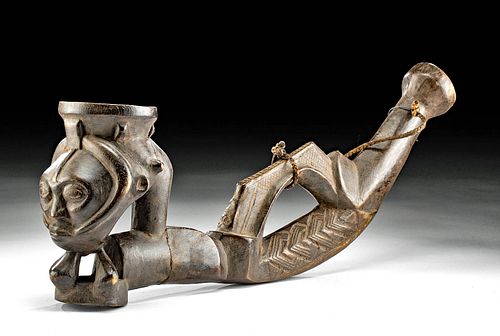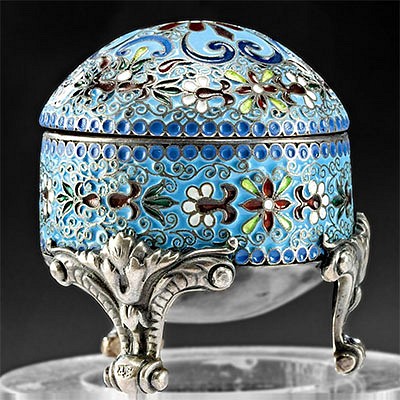19th C. African Kuba Figural Wood Pipe
Lot 17
About Seller
Artemis Fine Arts
686 S Taylor Ave, Ste 106
Louisville, CO 80027
United States
Selling antiquities, ancient and ethnographic art online since 1993, Artemis Gallery specializes in Classical Antiquities (Egyptian, Greek, Roman, Near Eastern), Asian, Pre-Columbian, African / Tribal / Oceanographic art. Our extensive inventory includes pottery, stone, metal, wood, glass and textil...Read more
Categories
Estimate:
$600 - $900
Absentee vs Live bid
Two ways to bid:
- Leave a max absentee bid and the platform will bid on your behalf up to your maximum bid during the live auction.
- Bid live during the auction and your bids will be submitted real-time to the auctioneer.
Bid Increments
| Price | Bid Increment |
|---|---|
| $0 | $25 |
| $300 | $50 |
| $1,000 | $100 |
| $2,000 | $250 |
| $5,000 | $500 |
| $10,000 | $1,000 |
| $20,000 | $2,500 |
| $50,000 | $5,000 |
| $100,000 | $10,000 |
| $200,000 | $20,000 |
About Auction
By Artemis Fine Arts
Apr 1, 2021
Set Reminder
2021-04-01 12:00:00
2021-04-01 12:00:00
America/New_York
Bidsquare
Bidsquare : Odd Unusual Finds | Antiquity to Present Day
https://www.bidsquare.com/auctions/artemis-gallery/odd-unusual-finds-antiquity-to-present-day-6742
Ancient, Asian, Pre-Columbian, Ethnographic, American, and everything in-between Wild, weird, strange, interesting - who knows what you'll find. All pieces guaranteed to be as described. Convenient in-house shipping. Artemis Fine Arts info@artemisfinearts.com
Ancient, Asian, Pre-Columbian, Ethnographic, American, and everything in-between Wild, weird, strange, interesting - who knows what you'll find. All pieces guaranteed to be as described. Convenient in-house shipping. Artemis Fine Arts info@artemisfinearts.com
- Lot Description
Central Africa, Dominican Republic of Congo, Kuba peoples, ca. late 19th to early 20th century CE. A stunning, hand-carved, wooden pipe used for smoking tobacco displaying a stylized bowl in the form of a human head and an elongated, curved stem, intricately incised with lovely geometric motifs. The fascinating chamber sits upon a circular foot with three spikes holding up the anthropomorphic bowl, which is topped by a flared rim. Framed by two c-shaped tresses of hair representing ram's horns, the fascinating visage presents a pair of heavy-lidded, almond-shaped eyes beneath a curved brow, a flat nose with broad nostrils, and a closed-lip mouth above a pointed chin. Two petite ears and a pair of bulging nubs sit behind the lengthy tresses of hair. The swooping stem has been carefully carved to feature a bridge-like handle decorated with an upside-down head that faces the bowl, while the hemispherical lip exhibits a projecting piece avian bone, likely intended to serve as a mouth piece. Size: 14" L x 3.75" W x 6.5" H (35.6 cm x 9.5 cm x 16.5 cm)
According to Kristen Windmuller-Luna, the Sylvan C. Coleman and Pam Coleman Memorial Fund Fellow in the Department of the Arts of Africa, Oceania, and the Americas at the Metropolitan Museum of Art, "The origins of pipe smoking in West Central Africa have been debated; tobacco itself was likely introduced from the Americas by the Portuguese in the sixteenth century. (Philips 1983, 308, 317). By the time that European and American observers first visited the Kuba kingdom in the nineteenth century, tobacco smoking was a well-established social practice there."
The Kuba kingdom was founded in the early seventeenth century and consisted of an elaborate, merit-based system of courtly titles in which positions of power were awarded rather than inherited. Due to this, aristocratic members of the Kuba kingdom frequently commissioned refined personal accessories, such as this example, to display their achievements. This pipe bears a striking resemblance to the anthropomorphic vessels used by Kuba elites to demonstrate their wealth and generosity by distributing large quantities of palm wine to their friends and associates. This wonderful implement exhibits several traditional Kuba characteristics, such as a closed mouth reflecting the belief that thought should precede speech, a shaved hairline that frames the forehead, which was believed to be the seat of wisdom and insight, and c-shaped tresses of hair that allude to ram’s horns, as sheep were a royal privilege of the nyim (Kuba ruler) and his family and thus another symbol of one's status.
Provenance: private San Francisco, California, USA collection, acquired 1970s to 2000s
All items legal to buy/sell under U.S. Statute covering cultural patrimony Code 2600, CHAPTER 14, and are guaranteed to be as described or your money back.
A Certificate of Authenticity will accompany all winning bids.
We ship worldwide and handle all shipping in-house for your convenience.
#137908Chipping to tip of avian bone lip. Repaired from at least three pieces with break line visible in some areas and restoration over break lines in others. Two minor fissures on stem and abraded area on bit. Expected nicks and abraded areas, commensurate with age and use. Otherwise, very nice with lovely patina.Condition
- Shipping Info
-
All shipping is handled in-house for your convenience. Your invoice from Artemis Gallery will include shipping calculation instructions. If in doubt, please inquire BEFORE bidding for estimated shipping costs for individual items.
-
- Buyer's Premium



 EUR
EUR CAD
CAD AUD
AUD GBP
GBP MXN
MXN HKD
HKD CNY
CNY MYR
MYR SEK
SEK SGD
SGD CHF
CHF THB
THB













